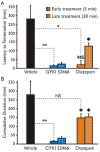Treatment of early and late kainic acid-induced status epilepticus with the noncompetitive AMPA receptor antagonist GYKI 52466
- PMID: 19682025
- PMCID: PMC4535693
- DOI: 10.1111/j.1528-1167.2009.02205.x
Treatment of early and late kainic acid-induced status epilepticus with the noncompetitive AMPA receptor antagonist GYKI 52466
Abstract
Purpose: Benzodiazepines such as diazepam may fail to effectively treat status epilepticus because benzodiazepine-sensitive GABA(A) receptors are progressively internalized with continued seizure activity. Ionotropic glutamate receptors, including AMPA receptors, are externalized, so that AMPA receptor antagonists, which are broad-spectrum anticonvulsants, could be more effective treatments for status epilepticus. We assessed the ability of the noncompetitive AMPA receptor antagonist GYKI 52466 to protect against kainic acid-induced status epilepticus in mice.
Methods: Groups of animals treated with kainic acid received GYKI 52466 (50 mg/kg followed in 15 min by 50 mg/kg) or diazepam (25 mg/kg followed in 20 min by 12.5 mg/kg) beginning at 5 min of continuous seizure activity or 25 min later. The duration of seizure activity was determined by EEG recording from epidural cortical electrodes.
Results: Both GYKI 52466 and diazepam rapidly terminated electrographic and behavioral seizures when administered early. However, diazepam-treated animals exhibited more seizure recurrences. With late administration, GYKI 52466 also rapidly terminated seizures and they seldom recurred, whereas diazepam was slow to produce seizure control and recurrences were common. Although both treatments caused sedation, GYKI 52466-treated animals retained neurological responsiveness whereas diazepam-treated animals did not. GYKI 52466 did not affect blood pressure whereas diazepam caused a sustained drop in mean arterial pressure.
Discussion: Noncompetitive AMPA receptor antagonists represent a promising approach for early treatment of status epilepticus; they may also be effective at later times when there is refractoriness to benzodiazepines.
Conflict of interest statement
Disclosure: None of the authors has any conflict of interest to disclose.
Figures




References
-
- Abend NS, Dlugos DJ. Treatment of refractory status epilepticus: literature review and a proposed protocol. Pediatr Neurol. 2008;38:377–390. - PubMed
-
- Adams BD, Buckley NH, Kim JY, Tipps LB. Fosphenytoin may cause hemodynamically unstable bradydysrhythmias. J Emerg Med. 2006;30:75–79. - PubMed
-
- Alldredge BK, Gelb AM, Isaacs SM, Corry MD, Allen F, Ulrich S, Gottwald MD, O’Neil N, Neuhaus JM, Segal MR, Lowenstein DH. A comparison of lorazepam, diazepam, and placebo for the treatment of out-of-hospital status epilepticus. N Engl J Med. 2001;345:631–637. - PubMed
-
- Balannik V, Menniti FS, Paternain AV, Lerma J, Stern-Bach Y. Molecular mechanism of AMPA receptor noncompetitive antagonism. Neuron. 2005;48:279–288. - PubMed
-
- Bertram EH, Lothman EW. NMDA receptor antagonists and limbic status epilepticus: a comparison with standard anticonvulsants. Epilepsy Res. 1990;5:177–184. - PubMed
Publication types
MeSH terms
Substances
Grants and funding
LinkOut - more resources
Full Text Sources
Other Literature Sources

